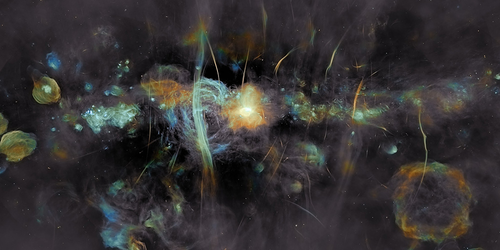Hunting for Axions in the Galactic Center
The axion—a hypothetical elementary particle—was originally conceived to solve a puzzle relating to one of the four fundamental forces. Theorists then found another use for this putative particle as a component of dark matter, the mysterious substance that makes up 27% of the Universe’s mass. One place axions could show up is in the radio spectra of neutron stars. Now researchers looking for that signature have derived a new upper limit on a key property of axions: how strongly they interact with photons [1].
One approach to detecting axions is to apply a strong magnetic field to a microwave cavity and then look for a predicted signal of axions converting into photons. In 2009 a pair of astronomers proposed that this conversion could also occur in the plasma threaded by a neutron star’s ultrastrong magnetic field. The conversion is predicted to manifest as a narrow, radio-frequency emission line whose exact frequency depends on the axion mass and whose amplitude depends on the axion density.
The predicted signal is beyond the reach of current telescopes. However, in 2020 the Massachusetts Institute of Technology’s Joshua Foster and his collaborators demonstrated that it’s possible to derive useful upper limits on the strength of axion-photon conversion by looking for the signal where it’s likely to be strongest: the Galactic Center.
Now the same team has looked for that signal in data gathered during a search for signatures of intelligent extraterrestrial life. They examine a higher and wider range of axion mass than before (15–35 𝜇eV versus 5–11 𝜇eV) and use a more detailed model of the neutron star population. Evidence of axions remains elusive, but the new interaction-strength bound is more stringent.
–Charles Day
Charles Day is a Senior Editor for Physics Magazine.
References
- J. W. Foster et al., “Extraterrestrial axion search with the Breakthrough Listen Galactic Center survey,” Phys. Rev. Lett. 129, 251102 (2022).




